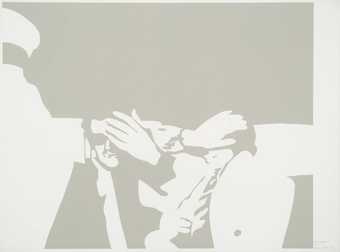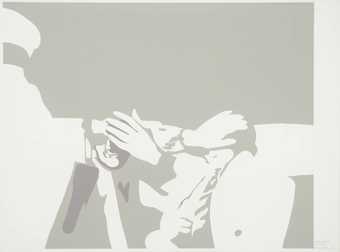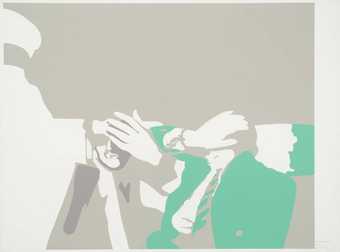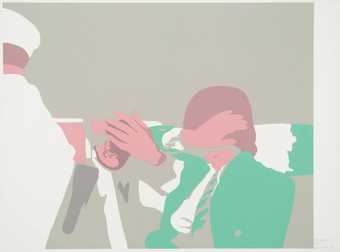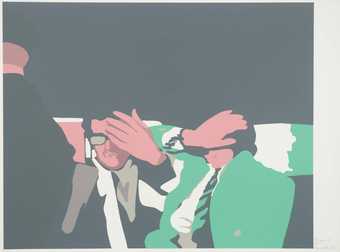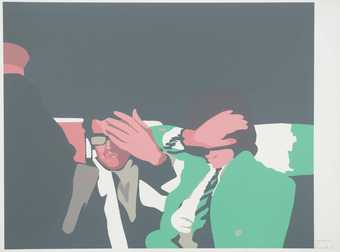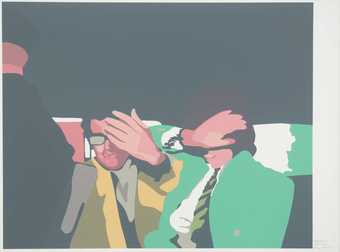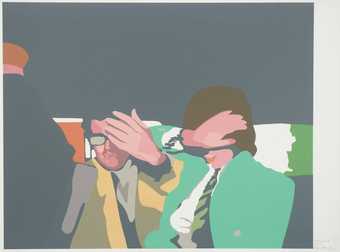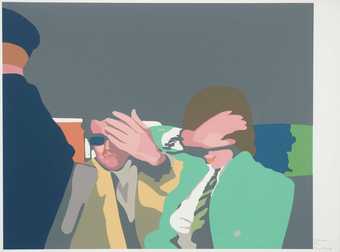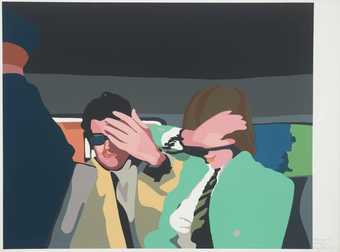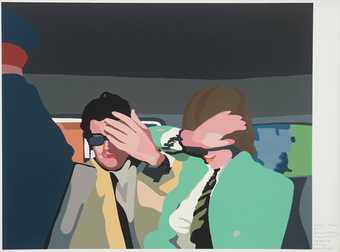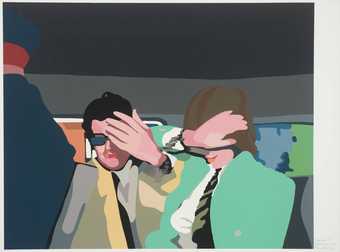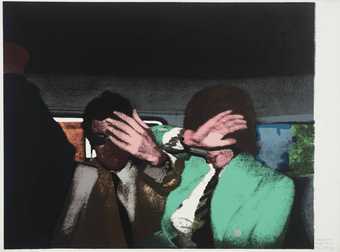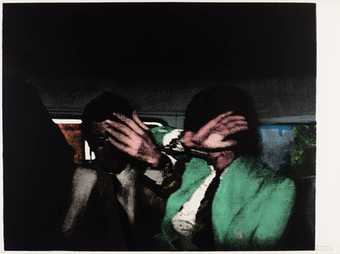
In Tate Britain
- Artist
- Richard Hamilton 1922–2011
- Medium
- Screenprint on paper
- Dimensions
- Image: 679 × 857 mm
- Collection
- Tate
- Acquisition
- Presented by Rose and Chris Prater through the Institute of Contemporary Prints 1975
- Reference
- P04255
Summary
Swingeing London III was generated by the process of creating the screenprint Release, 1972 (P04254). As the Release – Stage Proofs (P02416-32; the series is incomplete) show, Hamilton made Release by printing successive layers of colour through the use of seventeen hand-cut screens with a final addition of the black photographic screen giving photographic definition to the image. While he was building up the layers of colour on Release, the artist noticed that the composition worked well in its unfinished state, without the final black screen. He decided to create a poster version of the image by overprinting some of the surplus proofs. To make Swingeing London III the artist created a further seven screens for the application of seven additional layers of colour, enhancing the vividness of the tones visible on Stage Proofs 16 and 17. The resulting image, made up of areas of vivid flat colour, is an icon of Pop representation.
Swingeing London III derives its name from a group of works Hamilton began in 1967. These were inspired by the arrest and imprisonment of Hamilton’s art dealer Robert Fraser (1937-86) in 1967 for the possession of heroin. The artist had created a poster from a collage of press cuttings from the event entitled Swingeing London 67 – poster, 1967-8 (P01855), before embarking on a group of seven paintings entitled Swingeing London 67 1968 (private collection) and Swingeing London 67 (a)
– (f), 1968-9 (Swingeing London 67 (f) is T01144). The Swingeing London paintings are all based on the same image – a photograph of Robert Fraser and the rock star Mick Jagger in a police van being taken from jail to court. The photograph, taken by John Twine, was published in the Daily Sketch newspaper on 29 June 1967 and shows the two men, handcuffed together, trying to shield their faces from the press photographers. Hamilton had come across the image in the collection of press cuttings Fraser’s secretary had given to him when he was creating the print Swinging London 67 – poster and he placed it at the top left corner of the composition. In order to use the image to make an etching (Swingeing London 67 – etching, 1968) Hamilton had purchased a ten by eight inch print of the whole of Twine’s photograph from the Fleet Street offices of the Daily Sketch. He extended the picture on all four sides, revealing a police guard on the left and second van window on the right. The image was also enlarged up and down, showing the curve of the roof inside the van and more of the prisoners’ chests than had been previously visible. He retouched the photograph to remove the outside of the van and the overlapping glass of the sliding window that cut vertically through the centre of the image. After making these alterations, Hamilton planned to silkscreen the resulting photographic image in black over a coloured, conventional oil painting. As this involved extensive experimentation, Hamilton created seven paintings, making line drawings to define the various colour fields for each version. When he set out to make the print Release, he discovered that he had by chance kept the drawing defining the colour fields in the (e) painting and was able to use this as the basis for producing seventeen hand-cut stencils for building up the colours on the screenprint. For the final definition of the image in black, Hamilton created a photographic stencil from another accident: a photographic stencil created to use on the Swingeing London canvases had been cleaned of residual black ink between each use on a painting by pressing it on white paper, effectively creating a print. As the stencil had been used first on canvas, the texture of the fabric had been pressed into the black ink, with the result that the accidental proof had both the photographic image and the canvas texture. The completed print Release combines the seventeen colour screens and the photographic black screen. The build up of the image through the progressive addition of colour is documented by the series of stage proofs Hamilton donated to Tate in 1977 – Release – Stage Proofs 1-13 and 16-19 (P02416-32; the series is incomplete). Stage Proof 19 is identical to the print Release.
In the mid 1960s, Hamilton combined a newspaper photograph of a politician with a magazine photograph of a masked actor to create Hugh Gaitskell as a Famous Monster of Filmland (1963) (P78721), an image that satirized the leader of the Labour Party for what the artist felt was a betrayal of his party’s values. The Swingeing London works extend the motif of political concern being expressed through the medium of art. Hamilton felt strongly that the punishment of Fraser, nicknamed ‘Groovy Bob’ for his role as a trendsetter around which a lively social scene orbited, was inappropriate. He wrote:
I had felt a strong personal indignation at the insanity of legal institutions which could jail anyone for the offence of self-abuse with drugs. The sentence in the case of my friend Robert Fraser was blatantly not intended to help him through a sickness, it was to be a notorious example to others. As the judge declared ‘There are times when a swingeing sentence can act as a deterrent’. There were several moves towards the subject at the time of Robert’s arrest in 1967. Gradually, the sense of outrage subsided into quiet deliberations on the technical requirements of the expression of that anger.
(Quoted in Collected Words, p.104.)
Swingeing London III was printed by the artist and Chris Prater at Kelpra Studio, London on Hodgkinson mould-made paper using twenty-four hand-cut stencils and with the addition of die cut silver on the handcuffs and the frames of Fraser’s glasses. The edition was set at nineteen plus two artist’s proofs. Tate’s copy is a printer’s proof. The edition was published by Petersburg Press SA.
Further reading:
Etienne Lullin, Richard Hamilton: Prints and Multiples 1939-2002, exhibition catalogue, Kunstmuseum Winterthur and Yale Center for British Art, New Haven 2003, pp.116-7, reproduced p.117 in colour.
Richard Hamilton: Prints 1939-83, Stuttgart and London 1984, p.60, item 82, reproduced p.60 in colour.
Elizabeth Manchester
October 2007
Does this text contain inaccurate information or language that you feel we should improve or change? We would like to hear from you.
Explore
- emotions, concepts and ideas(16,416)
-
- formal qualities(12,454)
-
- colour(836)
- photographic(4,673)
- music and entertainment(2,331)
-
- music, pop(60)
- miscellaneous(732)
-
- handcuffs(27)
- actions: expressive(2,622)
-
- hiding(48)
- hand / hands raised(143)
- man(10,453)
- Fraser, Robert(21)
- Jagger, Mick(25)
- individuals: male(1,841)
- crime and punishment(436)
-
- arrest(33)
- illegal drugs(22)
- contemporary society(640)
- van(44)
- arts and entertainment(7,210)
-
- art dealer(328)
- singer(208)
You might like
-
Richard Hamilton Stage Proof 1
1972 -
Richard Hamilton Stage Proof 2
1972 -
Richard Hamilton Stage Proof 3
1972 -
Richard Hamilton Stage Proof 4
1972 -
Richard Hamilton Stage Proof 5
1972 -
Richard Hamilton Stage Proof 6
1972 -
Richard Hamilton Stage Proof 8
1972 -
Richard Hamilton Stage Proof 9
1972 -
Richard Hamilton Stage Proof 10
1972 -
Richard Hamilton Stage Proof 11
1972 -
Richard Hamilton Stage Proof 13
1972 -
Richard Hamilton Stage Proof 16
1972 -
Richard Hamilton Stage Proof 17
1972 -
Richard Hamilton Stage Proof 18
1972 -
Richard Hamilton Release
1972

